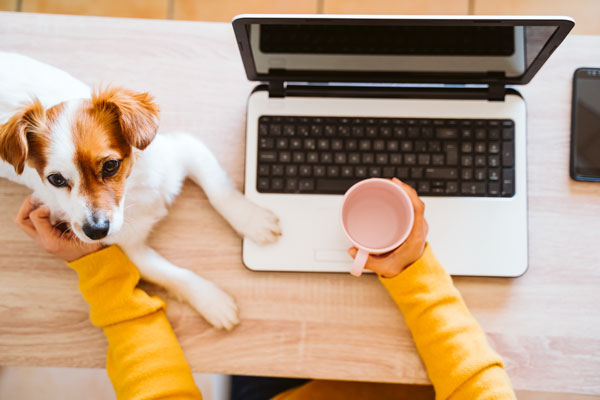For a lot of us, the first few days of working from home felt more like a snow day than a workday. Spending the day in sweatpants and taking calls from the couch has provided some much-needed relaxation amid the uncertainty we’ve faced in the past year.
But as we begin to regain some semblance of normalcy in our daily lives, many companies are announcing that they intend to integrate/continue remote work options for the foreseeable future, and possibly permanently. If this is the case, it’s crucial for new remote workers to adopt new habits to ensure they stay productive and healthy. Here are some of the most important tips for a positive work-from-home lifestyle:
Stick to Routines
Sticking to routines is one of the most important things we can do for our mental health. Humans thrive on consistency. But without the expectation of being in an office five days a week, it’s easy to slip out of structured, fulfilling habits.
Try and keep your morning routine similar to what it was when you were working in an office. Get up at your regular time, take a shower, and get dressed. Make a cup of coffee while you dish about the latest work drama with your pet. Make it feel as though you’re bringing a bit of the office home with you.
Sticking to a routine also means stepping away from work at the end of the day. You wouldn’t linger in the office at 5:00, so you shouldn’t feel obligated to work constantly just because your computer is an arm’s reach away. Research is showing that working from home has added upwards of three hours onto the average workday, citing earlier start times because people aren’t commuting and later clock-outs because there’s nowhere to go. Researchers at Harvard Business Review are reporting that the pandemic has significantly increased feelings of burnout, due in large part to companies and employees struggling to find a sustainable work-life balance for their remote workforce.
Though most are at the behest of their employers when it comes to work schedule and expectations, make the conscious effort to detach completely from work whenever possible. Log out of your work email and online communication platforms to avoid idle check-ins. Communicate actively with your team and your employers to ensure everyone is on the same page with how and when tasks are being done and when people are expected to be available for meetings. While self-care is an important element of avoiding workplace burnout and stress, it is also the responsibility of companies to adopt policies to the new landscape of work-life balance.
Create an Effective Workspace
Do your best to create a distraction-free workspace. Invest in a quality pair of noise-canceling headphones, remove any distracting knick-knacks or unnecessary electronics, close time-wasting tabs, and set boundaries with kids or other family members where you can.
In addition to mitigating distractions, an easy way to increase productivity is by modeling your home office after your real one. An office is full of sensory cues that help our brains focus on work, such as sounds, sight — even the feel of our desk chair. These sensations elicit specific moods and behaviors called affects. These affects help put us in the mindset of working, which can help drown out distractions and lessen the urge to step away from tasks to snack, do chores, etc.
If you’ve always had a bright yellow legal pad on your old desk, get one for your home space. If you’re an auditory person, you can even play some office-themed white noise recordings, equipped with typing noises, ambient chatter, the occasional squeak of a rolling chair, and the overhead AC.
Schedule Breaks
With the blurring lines between work and play and the comforts of home at your fingertips, it’s easy to get lost in your laptop for hours on end without stopping to rest or eat. The simplest way to combat this is by scheduling your breaks! If you struggle with following a basic alarm, there are apps and programs that bar you from using your computer for a set amount of time.
With the blurring lines between work and play and the comforts of home at your fingertips, it’s easy to get lost in your laptop for hours on end without stopping to rest or eat. The simplest way to combat this is by scheduling your breaks! If you struggle with following a basic alarm, there are apps and programs that prevent you from using your computer for a set amount of time.
It isn’t just the stomach and brain that need breaks — your eyeballs need rest, too! An easy way to prevent eye strain is the 20-20-20 rule. If you spend 20 minutes looking at a screen, take a break and peek out the window or step onto the porch for a breath of fresh air






